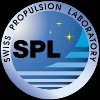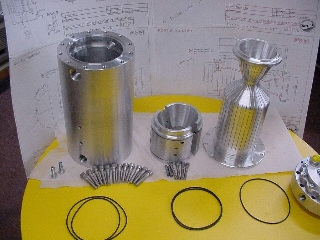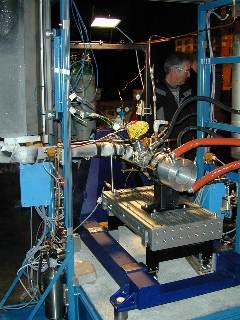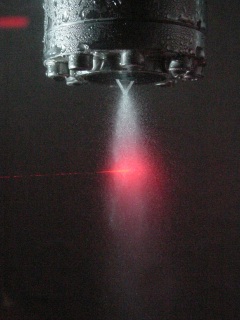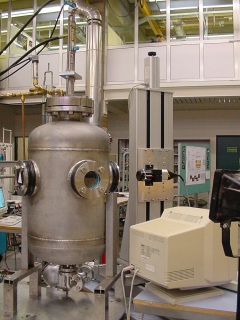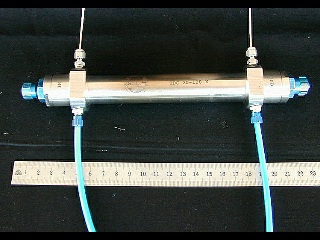|
| |
An
overview of what we can do for you. All products are ITAR-free or can
be made ITAR-free. Feel free to contact our sales
office if you have a question about our products or items on your
wish list currently not listed here.
|
|
| |
| Rocket
Engines/-Motors |
| 2.5
kN (560 lbs) regenerative cooled engine SLR2.5k-I |
SPL
and others such as XCOR
have built regenerative engines using separate chamber, throat
saddle, and outer jacket (CSJ-design). This engine uses exactly
this design. The outer jacket is shown in the left picture on
the left only. The jacket does not constrain the chamber’s
thermal expansion during firing. Thus the thermal strain, plastic
yield and cracking cycle never get started. In our engines we
haven't seen any distortion, yielding, or cracking. This construction
contributes to long life by making it feasible to disassemble
the engine for inspecting and removing coking deposits if needed.
We think this CSJ approach is good for thrust levels up to 100
kN and beyond. The mass of the engine is ~5 kg. It operates with
alcohol/LOX or kerosene/LOX at a chamber pressure of 25 bar (362
PSI) and is restartable.
| |
 |
| Parts
of the combustion chamber. The chamber is designed to be fully
demountable to test various configurations. This is also important
to inspect the liner and its cooling channels after test runs.
Click on the image to enlarge... |
The
inner liner with the milled cooling channels. One of the two
halves of the throat closeout has been removed. The closeout
mates very precisely with the liner to prevent any bypass
flow in the throat area. The temperatures in the cooling channels
are measured by thermocouples of 0.5mm diameter that are mounted
through small openings in the outer shell and in the closeout.
Click on the image to enlarge ... |
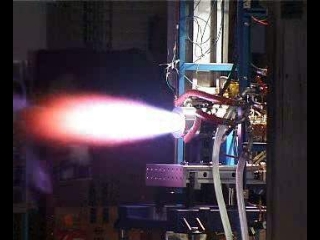 |
|
Ignition!
The picture shows a test run under rel. low chamber pressure
(o.6 MPa) using LOX/ethanol at an O/F of 1.3. In this test,
the injector was equipped with only 3 injector elements. |
An
overview of the test setup. One can clearly see the frozen
LOX line and LOX valve, the 2.5 kN chamber with its feeding
lines, the torch igniter and several thermocouples. The
LOX tank is on the top left.
The picture below shows a modified 2.5 kN engine at full
throttle |
| 
|
|
| 10
kN regenerative cooled engine SLR10k-I
(as used in the
X-Bow I Project) |
This
10kN (2.3 klbs) engine operates with Kerosene/LOX or Alcohol/LOX
and is also restartable. The injector can be fitted with an ablative
combustion chamber, a CSJ-chamber or with a dual pass copper chamber
surrounded with electro plated nickel. Chamber pressure is 25
bar (362 PSI)
| |
 |
| The
SLR10k-I injector fitted with a mockup chamber. The chamber
diameter is 140mm, throat is 56 mm. Nozzle is a 80% bell with
an expansion ratio of 1:5.6. Weight is about 7 Kg. It is equipped
with the complete injector plate, kerosene supply (movable
in two orthogonal axes) and the spherical LOX joint. |
The
combustion chamber consists of an inner copper liner with
machined cooling channels and an outer shell of electro plated
nickel. The picture shows a detail of a sample cutted out
of the electro plated combustion chamber wall. This design
is very light-weight and handles very high heat transfer densities.
The same principle is used in the SSME
and the Vulcain.
This design is subject to fatigue deformations and the cooling
channels are difficult to inspect. For reusability we suggest
our CSJ approach. |
|
| Reaction
control engines (RCS) |
We
have various engines suitable for attitude or reaction control.
This systems have been tested with GOX (gaseous oxygen), LOX (liquid
oxygen), nitrous oxide N2O as the oxidizer and various
hydrocarbons like ethanol (and other alcohols), kerosene, propane,
butane and ethane. We have also tested RCS engines based on catalytically
decomposed N2O and H2O2. The
thrust level of these engines is in the range of 1-200 N. These
engines can also act as igniters for bigger engines.
| |
 |
| A
RCS running on kerosene/GOX. Thrust 50N |
200
N thrust with ethanol/GOX |
|
| Solid
propulsion program |
SPL
has lots of experience with solid propellants. In the SSR12k-I
"Tethis" booster on the
picture below we tested fast burning mixtures based on HTPB/Al/AP
and Catocene respectively Butacene as very effective burning rate
modifiers. SPL has test equipment to characterize new propellants
under various conditions. Propellants are beeing processed remotely
by a ABB-robot. Have also a look at our igniters.
| |
 |
| The
SSR12k-I "Tethis"
booster. The nozzle contains a throat made of high density
graphite. This is a heavy walled test setting, not flight
hardware. |
Under
full thrust of 12'000 N. |
|
| Hot
water/steam propulsion |
SPL
and its partners developed several versions of hot water (steam)
boosters. They have been used as JATO boosters. Hot water rockets
are cheap to operate and environment-friendly and therefore perfect
to accelerate dollies, sledges for various applications or applying
high forces to structures like bridges for a short duration. We
can design and build devices with thrust levels of up to 50 metric
tons (110 k lbs).
| |
 |
| The
SHWR1.2k-I mounted on the test
stand. In front one can see the regulator for the 3 x3 kW
heating cartridges. Close to the nozzle one can see the security
valves and the pilot valve for the nozzle's internal valve. |
Hot
water rocket engines are safe devices. All engines are certified
by the national authorities. |
|
|
| |
| Igniters |
| Torch
igniters STI-I |
Our
torch igniters operate with gaseous oxygen and ethane, propane
or hydrogen. We use them on all of our engines and gas generators
(for turbo pumps). They made it through thousands of ignition
sequences without failure. Feeding pressure is up to 40 bar (580
PSI) or up to 60 bar (670 PSI) with H2/O2.
Diameter of the body is 40mm and the mass is ~300 grams (without
valves, plumbing and high tension source). If you prefer liquid
propellants for the igniters, then just have a look at our RCS
engines. We also made successful tests with catalytically ignited
H2/O2
devices (no spark or glow plug needed) and resonance igniters
(so-called Hartmann-Sprenger tubes).
| |
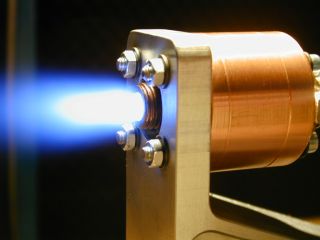 |
| The
torch igniter fires through the injector plate of modular
2.5 kN LOX/HC engine. On the left: the attached copper case
of the torch igniter with the spark plug. |
The
same type of igniter running on ethane/GOX |
|
| Pyrogen
Igniters SPI-MagTef
and SPI-I |
We
developed two types of pyrogen igniters for the solid propellant
motors. The SPI-MagTef bases on sintered
Magnesium/PTFE as made in a special process developed by SPL.
This igniter is a solid single piece, mechanical rugged and insensitive
to humidity (it even works submerged in water). The SPI-I
is a classical pyrogen design working like a small solid rocket
motor and can also be used as an igniter for liquid propellant
engines. Both
have been tested in the SSR12k-I "Tethis"
motor. We also tested basket
igniters based on Mg/PTFE- and Boron/KNO3-pellets.
| |
 |
| This
Mg/PTFE igniter brought the "Tethis" motor to full
thrust level of 12 kN within 30 ms without any pressure peaks |
The
SPI-I uses a silica-phenolic
housing containing a casted fast burning HTPB/AP grain |
| |
| A
cut-away view of the SPI-I |
|
|
| |
|
| |
|
| |
|
Consulting/Engineering |
-
Consulting/Engineering
We have done several design studies for various companies and
organizations. The example below is a proposal for a low thrust,
long burn time (and therefore regeneratively cooled) cruising
propulsion system:
-
CAD/CAE/CFD
We work with state of the art CAD/CAE. CFD (incompressible,
compressible flow up to mach 5) can be done via our university
partners, including wind tunnel tests.
|
|
| |
| Manufacturing
capabilities |
SPL
is integrated in the facilities of ARO
Technologies and has access to their infrastructure. Along with
CNC -milling machines (also 5-axes) and -lathes we can do EDM-,
wire EDM-, ECM and TIG/Plasma welding work.
|
|
| |
